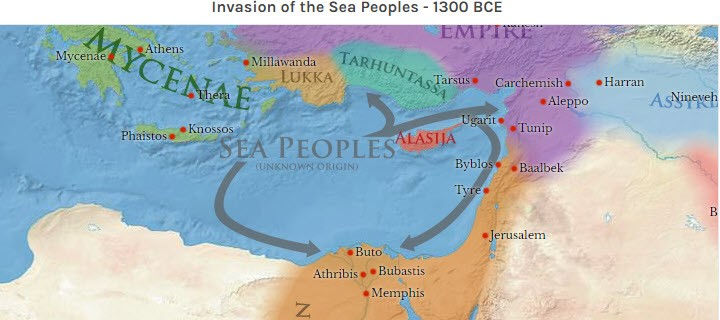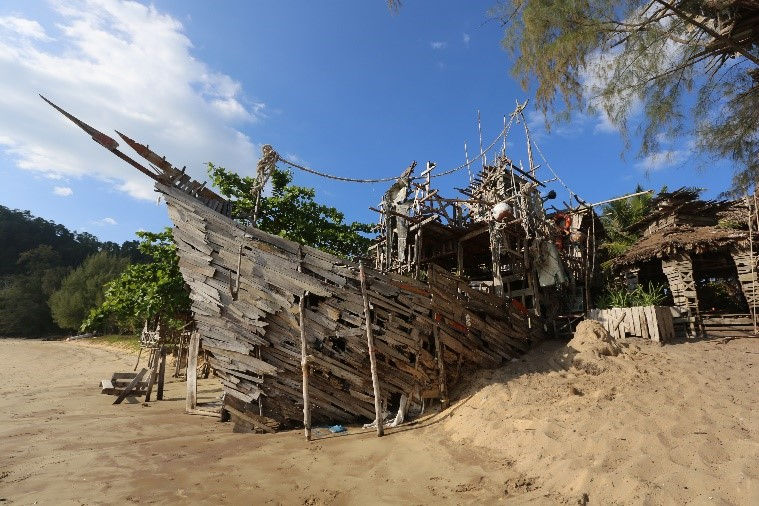Guest Post | The stories of pirates are as old as time by USA Today Bestseller @RuthACasie #pirates
- N. N. Light

- Jul 10, 2019
- 7 min read

In the Ancient World, there was a confederacy of naval raiders who harassed the coastal cities and maritime trade routes in the Mediterranean before the Vikings. Called by many names, today we know them as pirates.
Where did pirates live? In the Ancient World merchant ships never ventured far from land. They followed the coast by day and the stars by night. Pirate enclaves grew along rocky shores that provided shelter that was hidden from view. The safe havens that attracted pirates had several things in common:
Close to trade routes.
The local people were either desperate or friendly to pirates.
The locations were Isolated and discouraged people from going after them.
The location was in a pleasant climate.
The location had an established trading post and/or tavern where pirates were able to get supplies and dispose of their booty.
There were several places in the Ancient World known for their safe havens:
Lycia (present day Turkey) Their coastline contained many coves and inlets where pirates could lie in wait for heavily laden merchant ships that passed on a regular basis.
Cilicia (present day Turkey) was near the trade route that connected Syria to Italy and Greece. An added benefit was its proximity to Egyptian and Palestinian sea lanes and the presence of many rocky inlets, jutting headlands, and hidden anchorages, ideal for the raiders. Cilicia became the most notorious pirate haven of ancient times and was home to one of the largest enclaves of pirates in history.
Other ancient bases included Corfu, Santa Maura, Cephalonia, Miletus, Ephesus, Smyrna, the Balearic Islands, and Sicily.
The last refuge for pirates in this time period was in the Adriatic. Dalmatia’s coast made it difficult for pursuers to hunt down pirates. However, when Rome annexed Dalmatia in 9 CE, it ceased to be a haven for pirates.

Ancient World Pirate Ships. Mediterranean pirates sailed in galleys of various sizes with sleek, narrow hulls that cut quickly through the water. These ships often had a single sail. Oars were their primary means of propulsion. They were always in need of manpower for the oars. They filled the oarsman seats with conscripted men, slaves from their village raids. The more warlike galleys of the Ancient Greeks and Romans – triremes – had long battering rams attached to the bows and up to 170 slaves, seated on three tiers of benches. Pirate Tactics. Pirates preferred not to work in the winter due to rough seas and less merchant ships. Shipping and pirating started back up in the spring. Some pirates attacked during festivals when people were less likely to be on guard. There were pirates who posed as honest traders then turned on the merchant. At other times, pirates boldly sailed into port and attacked. Who protected the citizenry? A navy has always been somewhat of a deterrent to pirates. King Minos of Crete was the first ruler to keep a navy. His ships patrolled the eastern Mediterranean. He allowed trade to flow and was successful at restraining the pirates. About 1400 BC, Mount Thera, on the island of Santorini erupted. The eruption triggered a tsunami that wiped out the Minoans. With no one to stop them, the pirates returned.

Egypt. The Sea People targeted Egypt and invaded the country several times. There is evidence the pharaohs actively protected their borders from these raids. One of the battles was documented on a clay tablet dating back to 1350 BC, the reign of Pharaoh Akhenaton. Two hundred years later, Ramses III defended Egypt against the Sea People. The devastating raids on the Nile Delta crippled the region so badly it could no longer sustain life. The battle between Ramses’ and the Sea People was long and bloody, but the Sea People were defeated. A record of the battle can be found on an inscription at pharaoh’s mortuary temple at Thebes.
As a note: About 1881 AD, Egyptologist Gaston Maspero coined the term Sea People after studying ancient documents. These documents claimed that these raiders came “from the sea” or from “the islands” but never identified which islands. Who made up this confederacy remains a mystery to this day.
Greece. In 140 BC, the Ancient Greeks changed the lexicon. No longer were these raids made by sea robbers, but rather by mercenaries, pirate (peirato) Pirates collected tributes for these individual governments and, in times of war, utilized their skills and ships as navies to fight for the city-states. The pirates wanted the wealth for themselves and sometimes attacked coastal villages. To get away from these frequent attacks, people eventually moved their homes and businesses farther from the coast and when they rebuilt their cities, they fortified them.
According to Plutarch, a Greek biographer in the time of the glory of Rome about 100 AD, the Romans saw these pirates as enemies, not outlaws because they endangered the Roman State. As a result, Rome declared war against the pirates.

Rome. In 200 BC the traders of Rhodes armed their vessels and fought off pirate attacks. Their ships regularly protected maritime commerce around the Aegean Islands and entered into treaties with other countries to reduce the pirate’s safe haven. Illyria, (present day Albania, Serbia and Montenegro) was ruled by Queen Teuta, who ordered her navy to attack ships and coastal towns along the Adriatic and Ionian Seas. The Illyrians become so powerful that no honest traders wished to participate in maritime commerce. The Roman Empire did little to stop the attacks. They were busy elsewhere. After Illyrians raided a convoy of Roman ships laden with grain in the Adriatic Sea, Rome reevaluated their strategy and eliminated the Illyrians.
The next major pirate danger came from Cilicia, located between present-day Syria and Armenia. At the height of their power, these pirates almost crippled Ancient Rome’s maritime trade. In 69 BC, they attacked Delos, the legendary birthplace of Apollo and Artemis and an important commercial center in the Aegean. Aware that such power could well destroy the empire, Rome took action against the Cilicians. After securing the routes that supplied food to Rome, Gnaeus Pompeius campaigned against the Cilicians. He divided the Mediterranean and Black Seas into thirteen regions, each under the command of one of his officers. Their orders: destroy all pirate strongholds and force the Cilicians to surrender. Historical documents record that Pompeius captured at least 400 vessels while destroying more than 1,000 others. Ten thousand pirates died in battle, while twice that number surrendered. Captured pirates were often beheaded, crucified, or thrown to the lions, but Pompeius chose neither to imprison nor execute the Cilicians. Instead he distributed them and their families throughout the empire to inland locations where they could farm or conduct an honest livelihood. Although the Senate gave him three years to destroy the Cilicians, he achieved his goals in only forty-nine days.

Final Word. Once the pirates were gone, governments needed to maintain navies to prevent the pirates from returning. Ancient Rome. Sextus Pompeius (Gnaeus Pompeius’ son) was a Roman and gifted pirate. He turned the Mediterranean into a very dangerous place to do business. Sextus attacked any sea traffic that looked to be profitable and even began to raid the Italian coast. His band of supporters grew as he supplied a safe haven for all those condemned. After Julius Caesar’s death, civil wars led to an upsurge in piracy. Sextus, thinking himself a better man to rule Rome than Caesar’s heir decided to take on Octavian. Sextus built a fleet of ships and with the help of his pirates and escaped slaves, he attacked. Sextus and his crew were defeated in 36 BC. The pirates were either killed or fled inland. From then on, the Mediterranean enjoyed three centuries of freedom from pirate attacks.
Many thanks to Cindy Vallar for the insight and information for this post.

Wesley Reynolds will do anything to avenge his family’s banishment from Dundhragon Castle even throw in with the notorious pirate, MacAlpin. His plan: ruin Lord Ewan’s trading network. He has a more devious plan for his father’s best friend, the man who abandoned them at the eleventh hour. He’ll ruin the man’s most precious jewel, his daughter Darla. Wesley gets so close to succeeding he can almost taste it, but revenge is not nearly as sweet as Darla’s kisses.
Darla Maxwell, beloved by her parents has no prospects of marriage. Her father and Lord Ewan search to find the right husband. Darla’s special gifts are frightening to many. She has visions that often come true. The murky image of a man haunts her, she’s sure it’s Lord Ewan’s soon-to-be son-in-law, but the vision morphs when she meets Wesley. The meaning couldn’t be any clearer.
Revelations surface indicating Wesley has been deceived and his revenge misplaced. Will he find the truth of what really happened to his family in time to stop the pirates? Will Darla forgive him? Will he ever forgive himself?
Buy it now:
Free to read on Kindle Unlimited!
Amazon US https://www.amazon.com/dp/B07M81Y7HM
Amazon CA https://www.amazon.ca/dp/B07M81Y7HM
Amazon UK https://www.amazon.co.uk/dp/B07M81Y7HM

Author Biography:
RUTH A. CASIE is a USA Today bestselling author of historical swashbuckling action-adventures and contemporary romance with enough action to keep you turning pages. Her stories feature strong women and the men who deserve them, endearing flaws and all. She lives in New Jersey with her hero, three empty bedrooms and a growing number of incomplete counted cross-stitch projects. Before she found her voice, she was a speech therapist (pun intended), client liaison for a corrugated manufacturer, and vice president at an international bank where she was a product/ marketing manager, but her favorite job is the one she’s doing now—writing romance. She hopes her stories become your favorite adventures. For more information, please visit RuthACasie.com or visit her on Facebook, @RuthACasie, Twitter, @RuthACasie, or Pinterest RuthACasie.
Social Media Links:
Website: https://ruthacasie.com/
Email: mailto:ruth@ruthacasie.com
Personal Blog: http://www.ruthacasie.blogspot.com
Twitter: https://twitter.com/RuthACasie
Facebook Author Page: https://www.facebook.com/RuthACasie/
Pinterest: https://www.pinterest.com/ruthacasie/
YouTube: http://bit.ly/RuthACasieYouTube
Ruth’s Newsletter Signup: http://ruthacasie.com/contact.html#newsletter
Instagram: https://www.instagram.com/ruthacasie/
AllAuthor: http://ruthacasie.allauthor.com












